Inforgs & The Collective Infosphere
A Summary of the ecosystem works, by describing some old Diagrams. Since first publishing this article, i’ve continued to produce more diagrams; and they’ve been added to the document as a repository of sorts for them.

The Diagram below was first produced sometime around 2012–4(?); and has been slightly modified since.

What it speaks of is a definition of (human) ‘identity’ that is about all the attributed content relating to a person. The diagram then goes through some visual frames, as to illustrate how that information could be made useful for you, if you were able to be provided the useful rights to use that data. for your own needs.
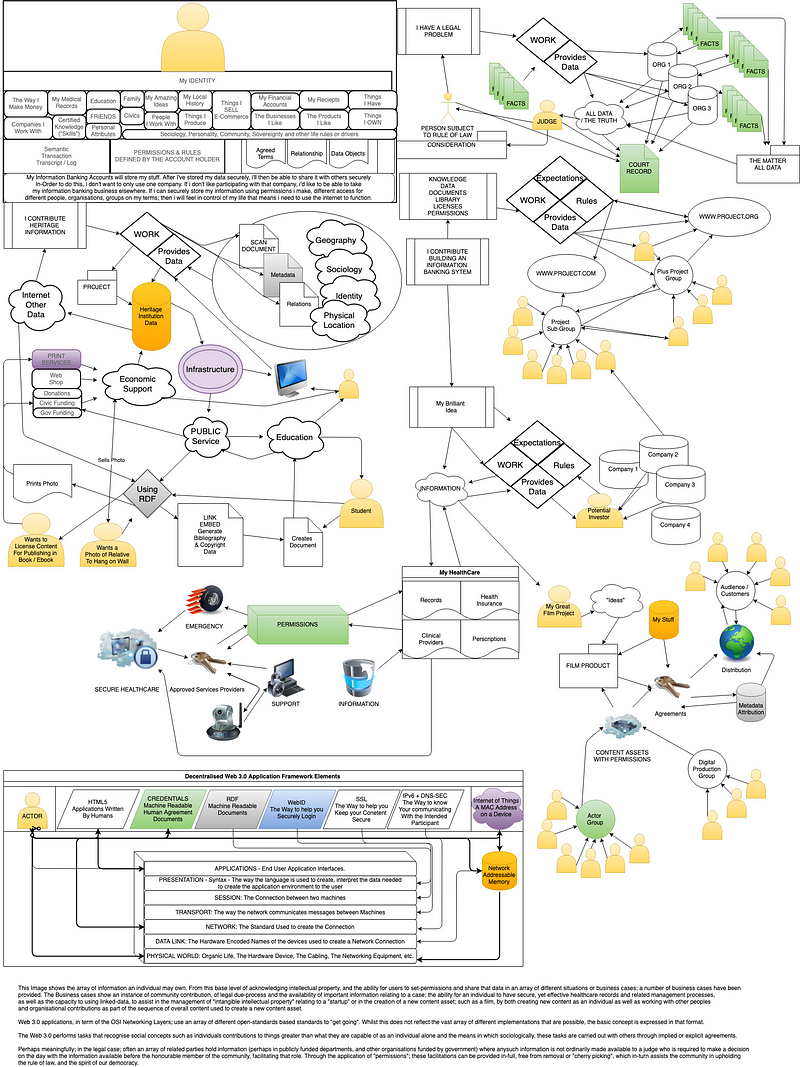
The low ever level of it, describes (in a way that was first inspired by the OSI model) describing how, the derivative objective of bringing together components from projects called RWW (now solid) and Credentials; alongside related technology projects, relates in-turn to ‘communications of facts’ and more broadly, interactions in the world — related to, digital identity.
2018, i made a few other diagrams; The most complex, is described below.
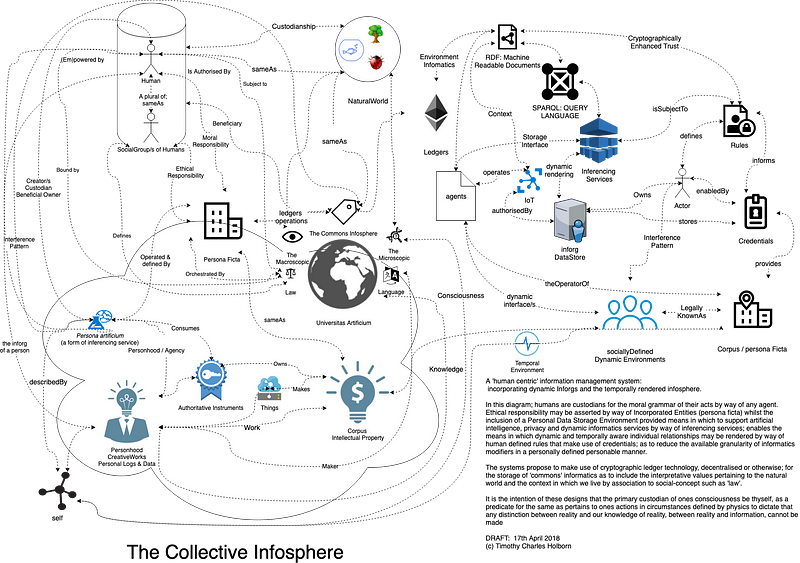
What this diagram attempts to present (although, somewhat poorly) is an array of ecosystem concepts / ideas, that interweave with each-other.
The permissive commons concept, is illustrated in relation to the use of ledgers (not necessarily ethereum, indeed ideally a DLT Open-Standards); and, the natural world — both on a macroscopic and microscopic level.
Basically therein — the concept is that knowledge about our world, must be distributed in a form that supports freedom of thought.
amongst other vitally supported, human rights related functionally (and economically) supported paradigms…
The knowledge banking methodology, is described by the ‘inforg’ & ‘inferencing services’, ingesting an array of RDF data-sources, including (but not limited to) 3rd party claims — or credentials.
Groups of people; are illustrated as ‘corpus / persona ficta’ or corporations / legal personalities (companies). The term ‘persona ficta’ is latin, for artificial person.
On the left hand side, there is a delineation between the moral responsibilities of acts, which relates to the individual person; and the ethical responsibility of acts, which relates in-turn to group dynamics.
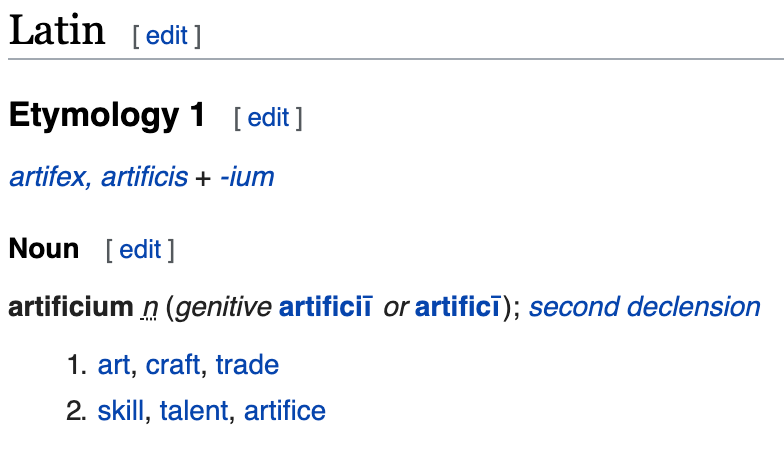
https://en.wiktionary.org/wiki/artificium
This is in-turn woven into a framework that is built upon a commons infosphere, that relates persons and authoritative instruments (trust) with the artificial world, ‘universitas artificium’,
Universitas is a Latin word meaning “the whole, total, the universe, the world”
whereby the relationships between natural persons, legal persons, the ‘knowledge of the world’ and persona artificium, or the dynamic representation of a person in any given (dynamic) context; is brought about.
This is then intended to support dignity (incorporating privacy considerations) alongside support for broader informatics structures
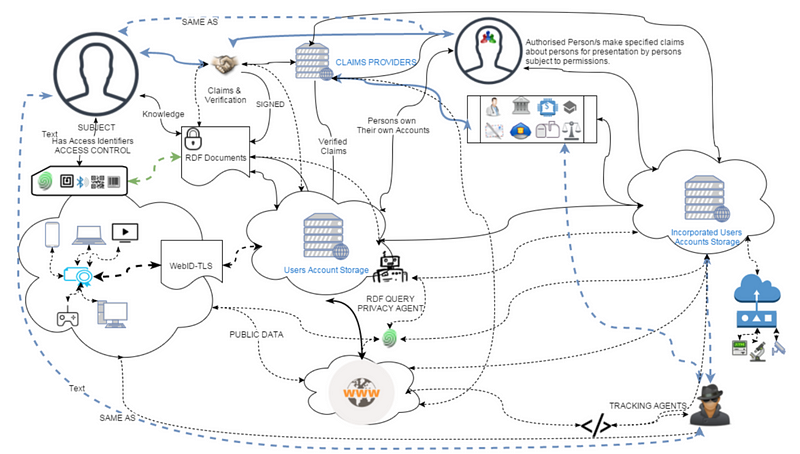
As is now otherwise described in the writings on medium under WebCivics.
The means through which we ‘think’, is for the most-part built upon our ‘learned’ or ‘lived experiences’.
“the distinction between reality and our knowledge of reality, between reality and information, cannot be made” Anton Zeilinger
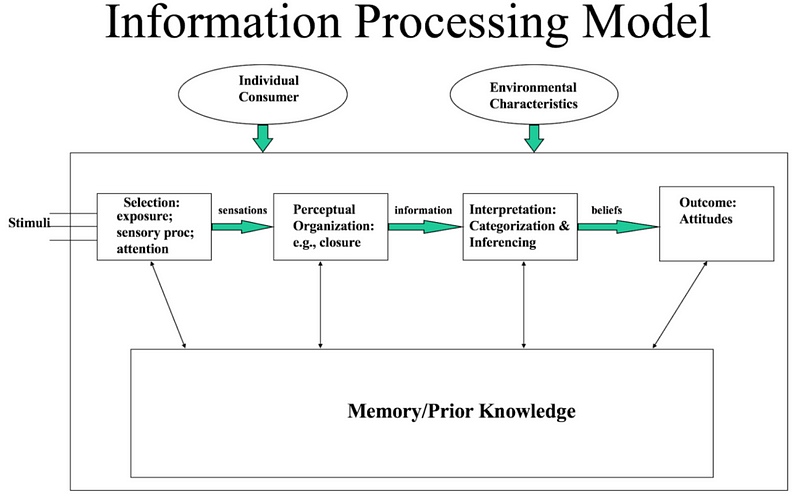
The manner in which any ‘information management’ system is managed, relates to different types of roles of actors; whereby relationships between the activities of an agent and/or actor carrying out that role; needs to be put in context by way of an ‘entity analysis’, evaluation model, modality or graph.
It is important to note that jurisdictional considerations have an influence on the definition, role and rights of each of these forms of ‘active actors’, in a manner that forms what is considered to be similar to an interference pattern, as may be programatically queried, evaluated and/or made use of.
HUMAN ACTORS:
- A human actor is the only current natural-world actor.
- A real-world actor may be subject to legal penalties in a manner that is distinct to the role of any other legal actor.
- Human actors are rendered means in which to socioeconomically participate by way of the socio-geopolitical mechanic of personhood; in which citizenship makes distinct those whom a series of interpretive definitions apply in a particular form of manifest; vs. those considered to be ‘alien’ to any-such geographically defined environment.
PERSONA FICTA; ‘LEGAL PERSON‘ OR ‘LEGAL PERSONALITY’
- legal personalities, incorporating a group of persons as to form a group personality which is rendered means of existence by way of shared responsibilities and whom by such means may own tangible legal rights whether ‘artificial’ (copyright), commons subject (law) or natural (land).
- Is operated by way of human actors whose responsibilities and custodianship may change from time to time.
An Artificial personalities that is brought about by the work of natural persons, to be an artificial and native actor within the infosphere whose acts influence the natural world; such as, a program, an applied machine learning algorithm and other forms of artificial intelligence.
- A work of art produced by one or more persons which by its operation brings cause to influence the acts of others in a manner that may or may not be intended by its custodians.
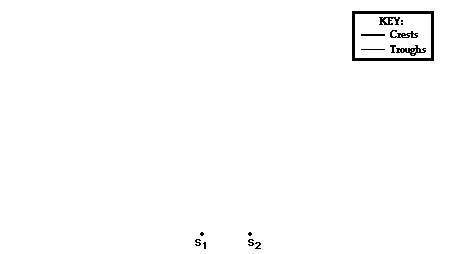
Interference & Modality
In the very top diagram (collective infosphere) there is an object in that diagram noted as temporal environment.
What this in-turn relates to is the information systems interaction or causality related ‘interference patterns’ with lived experiences, and the expenditures made (socio-economically) on / in any sitution.
The changes made by this new form of information and knowledge management system; that makes use of a ‘human centric’ approach, builds an informatics system that is guided by an interference pattern caused by individual human actors purposeful decision making practices.
In this way the information system develops a means in which to forge a comprehension of the intent, as is stored as part of a graph. Overtime, this is consumed by agents to process and evaluate characteristics.
Consequentially, there is vastly improved means to evaluate human actors.
updated diagrams below (13th Oct 2019)
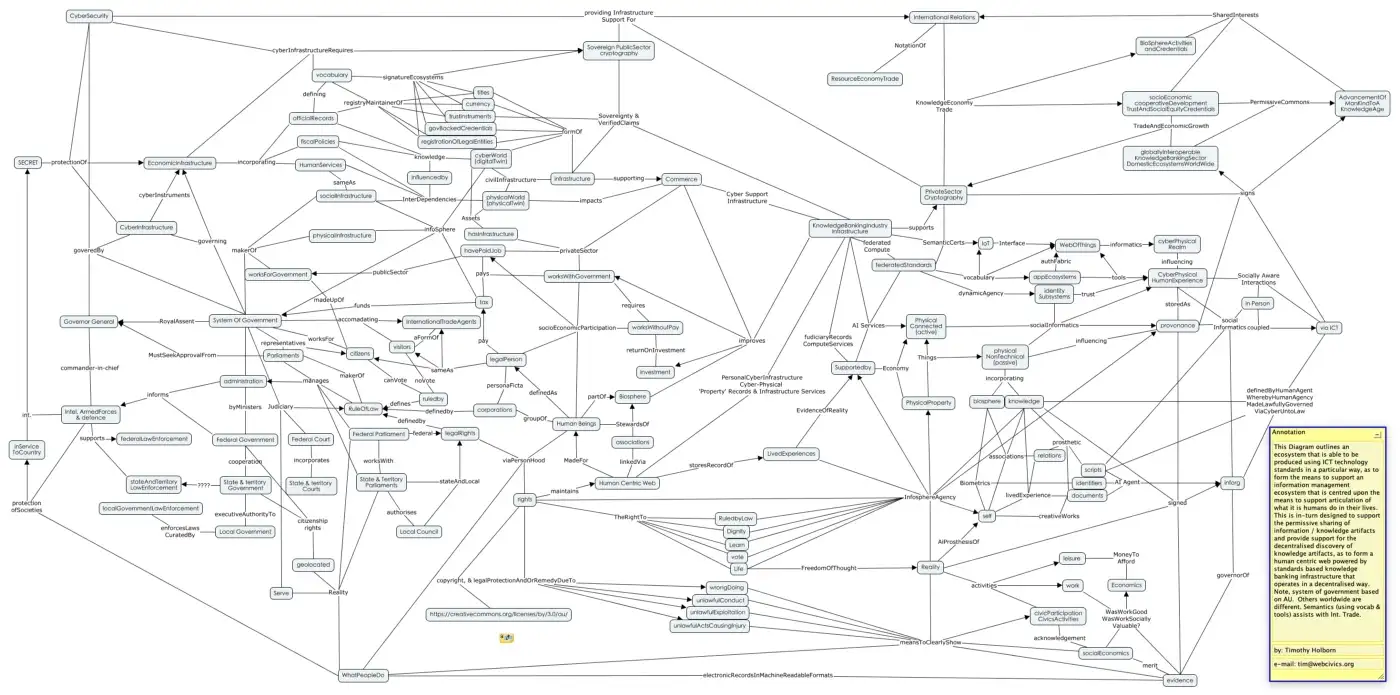




2020 (22nd Feb)

2020 update re: COVID / SocioEconomic Data (incomplete, but illustrative)

The False Dichotomy — initial Draft concept 20th sep 2020 (below)
The concept below is an attempt to illustrate binarism as is applied to various forms of systems projects; particularly as defined via digital infrastructure.

20th September 2020
‘Knowledge Cloud’ Inferencing concepts.
The concept of a ‘knowledge cloud’ is illustrated in a previously (draft) publication available here:
“Knowledge Clouds”
_A conceptual framework for complex systems design_medium.com
In furthering these considerations the below concept has been produced, which refers to a knowledge graph implementation modal structure (draft)

6th November 2020
When people call or recieve a call from a particular entity that is considered ‘trust-worthy’ for particular purpose(s); its not necessarily the case that the interaction is with the entity or an agent on behalf of that entity as may be assumed. In the world of Email this is often called spam; but the implication is in-fact far broader and moreover, particularly problematic in association to institutions of trust (ie: banks, government, healthcare providers, utilities, etc.). To illustrate this point i’ve produce the following draft diagram.

6th November 2020

15th October 2021
There’s an array of applications, one note about it is per below — recently found in my email catalogue…

Auguest 2017
The diagram below has been produced 3rd June 2022. It appears to me that there are various design implications, that i continue to make attempts to describe as being really very problematic. I am currently processing a requirements analysis that will hopefully end-up with an improved methodology to attend to issues of false-statements that may engender systemic harms. This diagram is a creative work that forms part of that process…

3rd June 2022 — The systemic impact of false-statements in institutional information management systems.
This is in-turn a supplemental piece to the broader ecosystem articles published on medium.